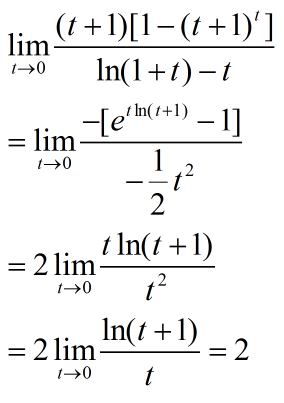There is a Limit to Everything
Calculus
Level
3
Find the value of the above expression.
The answer is 2.0.
This section requires Javascript.
You are seeing this because something didn't load right. We suggest you, (a) try
refreshing the page, (b) enabling javascript if it is disabled on your browser and,
finally, (c)
loading the
non-javascript version of this page
. We're sorry about the hassle.

Since the Limit is of the form 0 0 , we can use L'Hopital's Rule.
L = x → 1 lim 1 − x + ln x x − x x = x → 1 lim − 1 + x 1 1 − x x ( 1 + ln x )
This is again of the 0 0 form, so L'Hopital's Rule can be applied again.
L = x → 1 lim − 1 + x 1 1 − x x ( 1 + ln x ) = x → 1 lim x 2 − 1 − x x ( 1 + ln x ) 2 − x x ( x 1 ) = − 1 − 1 + − 1
⇒ L = 2
Note:
Let y = x x
⇒ ln y = x ln x ⇒ y 1 d x d y = x x + ln x
⇒ d x d y = y ( 1 + ln x ) = x x ( 1 + ln x )